Are you looking for a few consistently blooming brilliant flowers for your Kentucky garden? Look no further. Perennial flowers bloom, die back, and emerge again the following year. In contrast, annual flowers germinate, flower, set seed, and die all in one year, and staunch evergreens remain lush all year round. This list looks at the best perennial flowers for Kentucky so you won’t find evergreens or annuals here.
Kentucky Growing Zones
The USDA plant hardiness zone map places Kentucky in Zone 6, with some of western Kentucky in Zone 7A. This means warm to hot summers and mild to cold winters. Lots of perennials enjoy these conditions, so Kentucky’s gardeners have many blooming lovely perennials to choose from.
1. Shasta Daisies
Shasta daisies grow in zones 4-8. These beautiful, simple flowers are one of the best perennials for Kentucky with their cheerful yellow centers, white-rayed petals, and easy-growing nature.
Plant-rooted cuttings or fully grown bought shastas in late spring, and they’ll produce flowers that summer, whereas seeds will flower the following year.
Shasta daisies reach two to four feet tall, and they love full sun or partial shade. The best soil is fertile and well-drained, but they cope well with poor or rocky soil, too. Just pop a layer of well-rotted organic mulch around the base in early spring or fall.

Classy shasta daisies bloom in late spring until late summer.
©Heeji Choi/Shutterstock.com
2. Erigeron
And speaking of perennial daisies, Erigeron, the seaside daisy or fleabane plant, is another big-hitting Kentucky perennial. In contrast to shasta daisies, Erigeron has a plethora of small daisy-like flowers on drought-hardy, green-gray foliage.
Erigeron grows in rocky, sandy soil, overspills a wall, cascades from hanging baskets, and softens container edges every year. Plant it in early spring and water well until it’s established for blooms in mid-summer until the first hard frost.
Seaside daisy loves full sun or partial shade; just cut it back in late fall, and it re-emerges bigger and better the following spring.
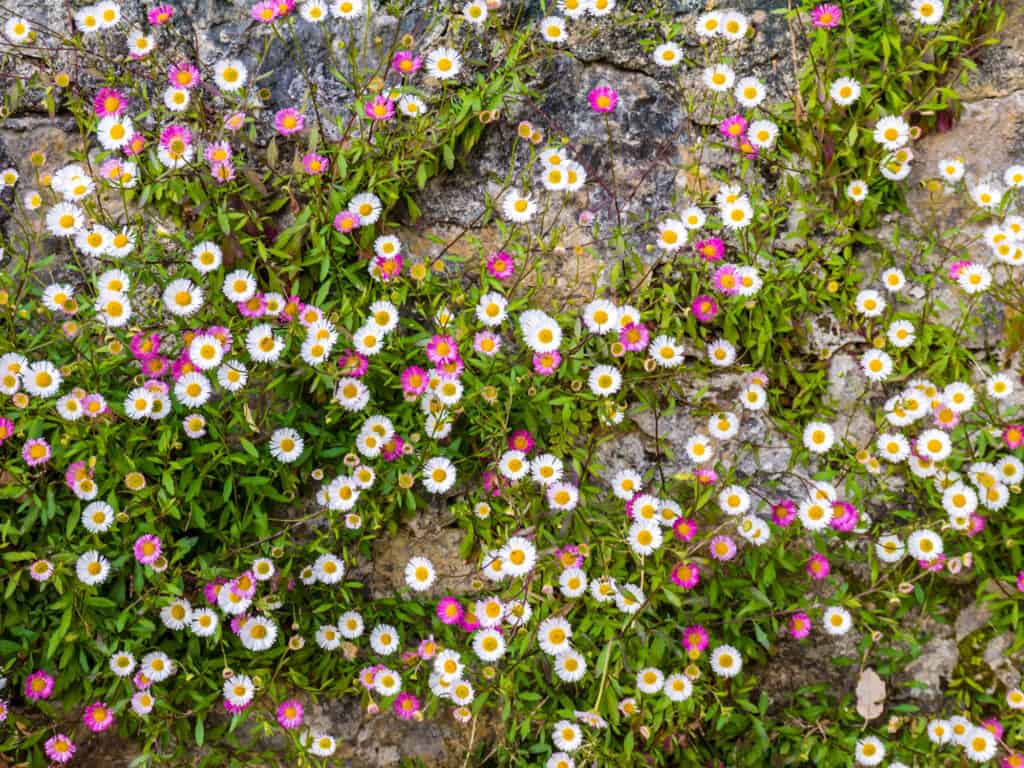
Erigeron is better known as fleabane or the seaside daisy.
©iStock.com/photohampster
3. Agapanthus
South African native agapanthus is commonly called African lily or Lily-of-the-Nile. It’s a stunning bloomer with spheres of white, blue, or white and blue striped flowers on tall stems. Its strappy, lush green foliage protects the soil and helps it cope with drought. It can be a little cold and tender, so this is a better choice for western Kentucky’s milder winters.
Plant it in full sun to part shade in well-drained, fertile soil or a large container. Bees and hummingbirds universally love perennial agapanthus’ tubular flowerheads. That alone makes it one of the best perennial flowers for Kentucky.
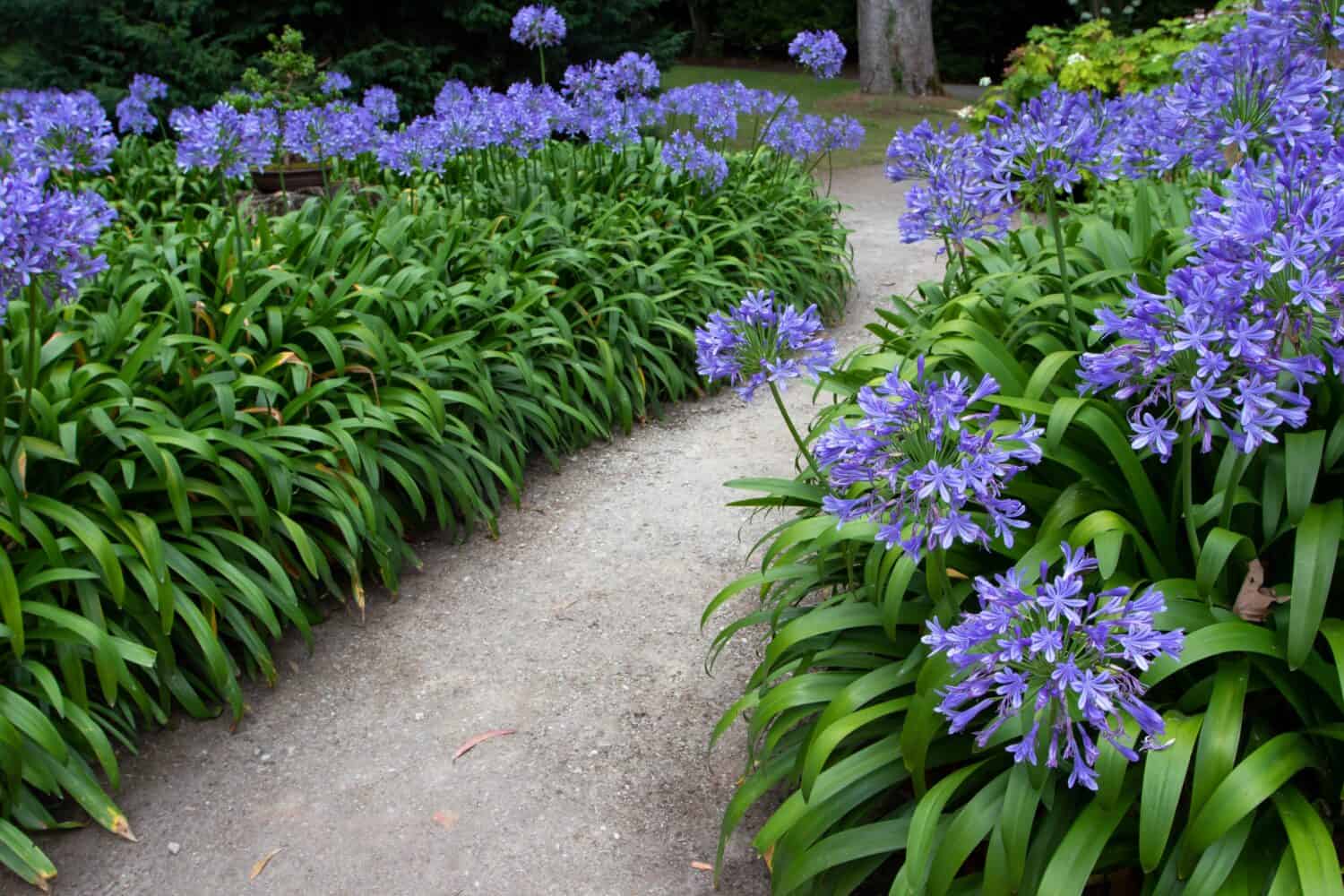
Lily-of-the-Nile is a hummingbird favorite.
©Svetlana Zhukova/Shutterstock.com
4. Dahlia
A tropical, multi-colored dahlia display is hard to beat. Depending on the varieties, these perennial beauties bloom white, pink, yellow, peach, orange, red, or purple flowers on two-to-six-foot tall stems.
Sun is a must for these heat-seeking perennials, and they need water to keep flowering from spring to fall. Because dahlias are tropical, it’s best to dig the tubers up in late fall and replant them the following spring to prevent rot or frost damage.
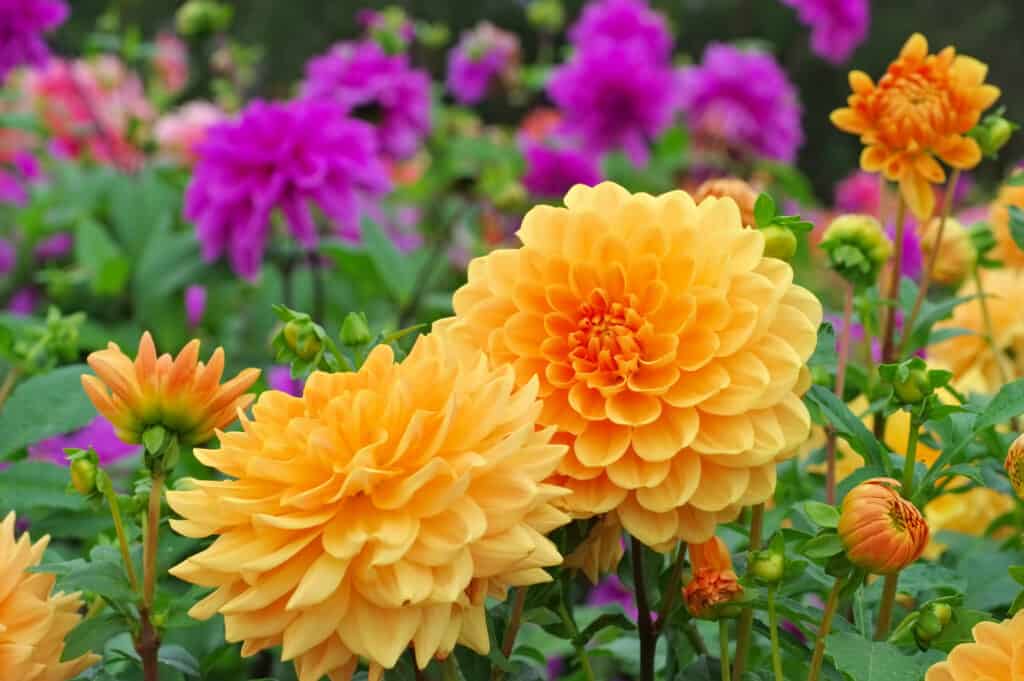
It’s best to dig up dahlia tubers in Kentucky to avoid winter rot.
©iStock.com/LianeM
5. Coreopsis
Coreopsis thrives in zones 4-7, so it’s a reliable choice for Kentucky gardens. With its bright yellow shock of flowers, this one is difficult to miss! Its blaze of two-inch wide butter-yellow blooms sits atop thin stems and dark green skinny foliage. Best of all, it’s very low maintenance.
It’s native, so coreopsis attracts pollinators and survives cold winters. In Kentucky, it blooms in June. Plant it in early spring for flowers that year or in the fall for flowers the following year. Coreopsis needs full sun and well-drained soil, and if you remove dead flowers, it’ll brighten your yard for months.

Butter-yellow coreopsis is reliable and low maintenance in Kentucky.
©skymoon13/iStock via Getty Images
6. Tulips
Red tulips are a Derby Day tradition, and one of the best of these perennial bulbs is Anfield Fringe.
It has distinctive bright red fringed petals that combined make six-inch wide flowers. They’ll reach 12 inches in height and form a focal point in early spring.
Plant Kentucky tulips in the fall (October is best because it’s warm and not too wet), and they’ll push up from March to April. Tulips need full sun or partial shade and well-drained soil. If your soil is clay or compact, try a container instead; tulips do well in pots.
Once spent, let the foliage die away naturally because this process feeds bulbs for a bright display the following year. If you hate dying foliage, try planting them behind perennial shrubs.
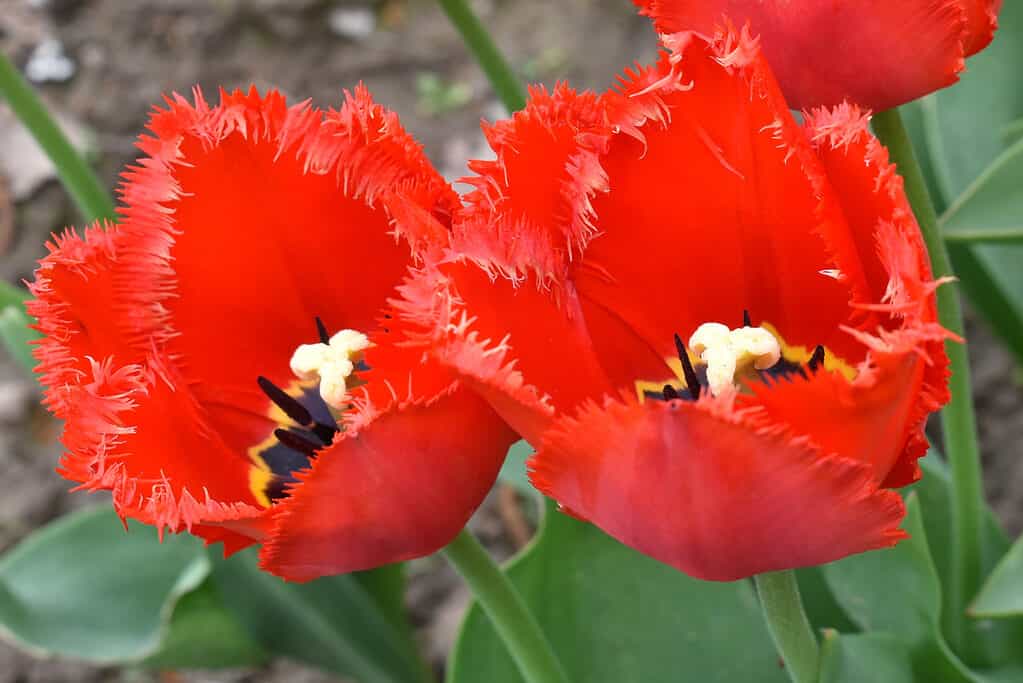
Bright red tulips are a Derby Day classic. They need well-drained soil.
©Ritvars/Shutterstock.com
7. Hellebores
Winter flowering hellebore, commonly called lenten rose, blooms in the drab winter months and dies back over spring and summer, although in warm areas, they might remain evergreen. It’s one of the best perennials for Kentucky because it brings winter color and feeds early-waking pollinators.
It’ll grow across Kentucky state, blooming white, red, yellow, or purple bell-shaped flowers for ten weeks. Hellebores reach 18 inches tall and love moist, well-drained soil with extra organic matter. A sunny spot with some shelter from freezing winds suits it best. Plant hellebore in the fall and expect flowers from November to January.
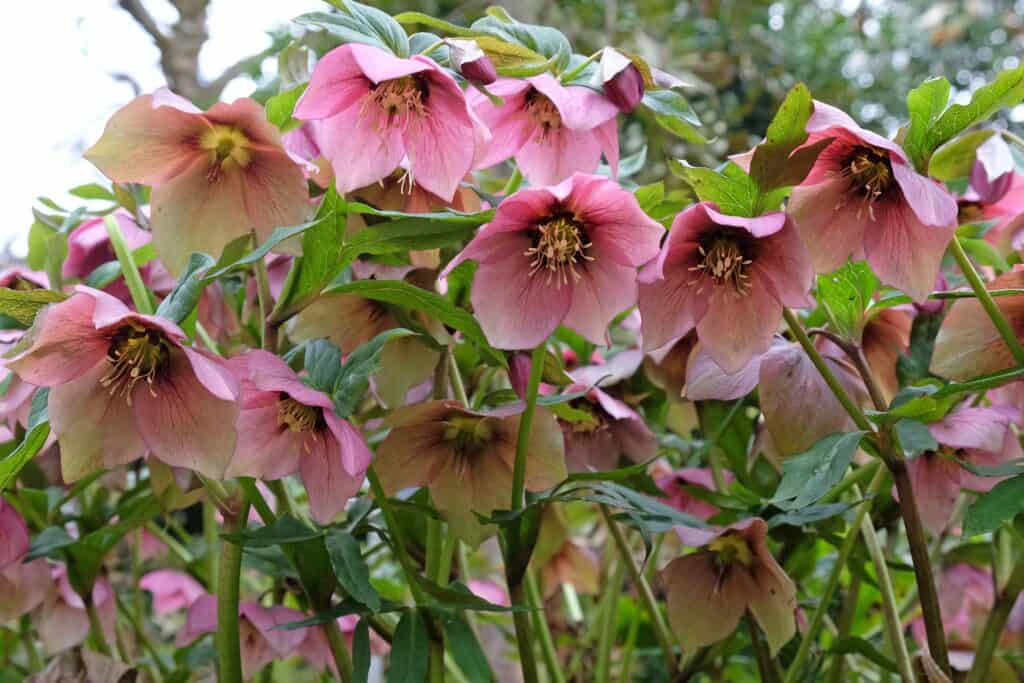
Lenten rose is a winter-flowering perennial that brings color to drab ,dark gardens.
©Alex Manders/Shutterstock.com
8. Sedum
Late fall flowering sedums bring much-needed color and nectar to Kentucky gardens. These drought-proof beauties have thick, fleshy leaves that hold onto water and pink, white, red, or orange flower clusters that butterflies and bees adore.
Plant sedum in a spot that captures full sun during early spring and expects flowers from late August to Halloween. It suits poor, rocky soil that drains quickly, so a rockery or container is ideal. Sedum foliage dies back over Christmas and New Year before re-emerging in spring.

Butterflies, like these peacocks, drink sedum nectar in the fall.
©iStock.com/Christian Peters
9. Epimedium
Clump-forming perennial epimediums tolerate most conditions in USDA zones 5-8 and need so little maintenance that it’s fine to leave them to their own devices.
Semi-evergreen shade-loving epimediums suit cool Kentucky gardens. Their spiky-edged foliage and delicate small yellow-white or purple flower sprays are deer and rabbit-resistant. Once established, this beauty is self-reliant, copes with drought, and is rarely bothered by pests. Pollinators flock to its blooms.
Plant out in early spring or the fall, and expect flowers in April to May. Epimediums cope with full sun, but they prefer a partly shaded spot in any type of well-drained soil. This ground cover reaches around eight inches tall and slowly spreads to cover bare soil.

Epimedium is also called Barrenwort. It’s a small perennial purple flower.
©YUMIK/Shutterstock.com
10. Daffodils
Cheerful daffodils emerge from February to April each year and die back in late spring. When dilly-daffs bloom, it means approaching warmer weather.
Daffodils provide nectar for early waking pollinators, and their cheerful pop of yellow lifts Kentucky’s spirits. They range from just a few inches tall to 18 inches, depending on the species. Smaller daffs suit containers and slopes, whereas taller daffodils do best in a sheltered spot.
Plant bulbs out in fall, and they’ll bloom from February, or buy flowering daffodils to plant in early spring. Their bulbs rot in soggy soil, so a well-drained spot in full sun or partial shade is essential.

Bright and cheerful daffodils are one of the first perennials to flower in Kentucky.
©Walter Erhardt/Shutterstock.com
11. Amsonia
Beautiful blue amsonia is a rarity in Kentucky gardens. Its beautiful blue-sky star-shaped flowers emerge from dusky blue buds in late spring and bloom throughout summer. In fall, its strappy foliage matures to rich gold.
This underused perennial is native to North America, the Mediterranean, and Japan. The blue star plant prefers full sun or partial shade in zones 3-9. It can reach three feet tall each year and needs lots of organic mulch to feed its baby blue blooms.
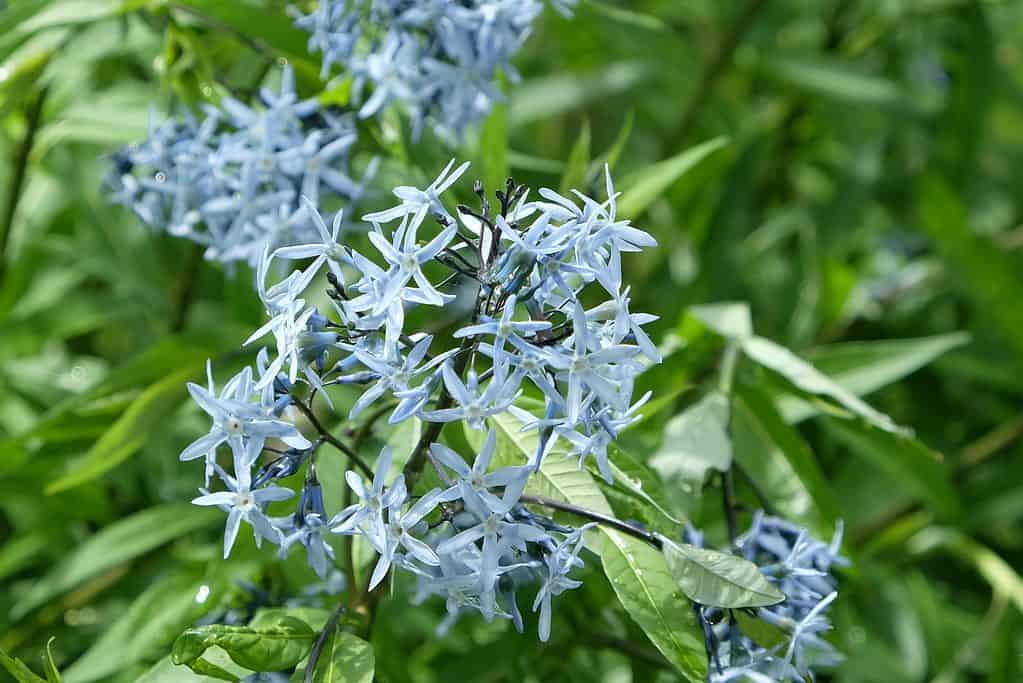
Amsonia, the blue star plant, flowers in late spring until the fall.
©Alex Manders/Shutterstock.com
12. Campanula
Campanula’s foliage emerges in early spring, followed by purple-blue star-shaped flowers in late spring. With its heart-shaped leaves and ability to quickly spread and cover soil, it’s a favorite Kentucky perennial in wildlife-friendly, low-maintenance gardens.
Best known as bell flowers, campanula varieties range from white to deep purple. They prefer a moist, shady spot and perform best with cool roots. A great naturalizer, campanula re-seeds around damp areas of the garden. Plant bellflowers out in spring, and they’ll flower all summer long before dying down for winter.
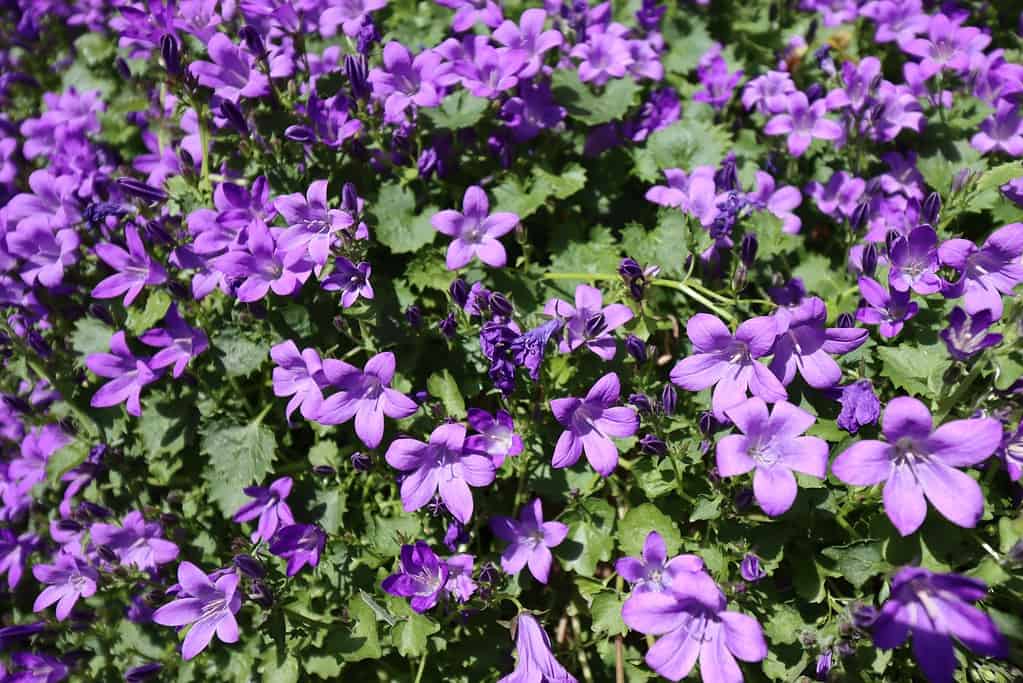
Bellflowers prefer moist soil and part shade. In the right conditions they colonize gardens.
©Gylando501/Shutterstock.com
13. Coneflower
Native coneflower plants grow to three feet tall by three feet wide and produce drooping petals clustered around a cone-shaped center. These perennials are top-of-the-range pollinator food stations and look handsome in a mixed wildflower border.
Kentucky gardeners can plant coneflower from seed in spring and expect flowers in late summer. The following year, flowers emerge in late April and bloom until September.
Because coneflowers are a native perennial, they need little care. Plant them in full sun in well-drained, reasonably fertile soil, and they work hard to produce masses of large, colorful flowers. In the fall, flowerheads mature into seeds that small finches adore.
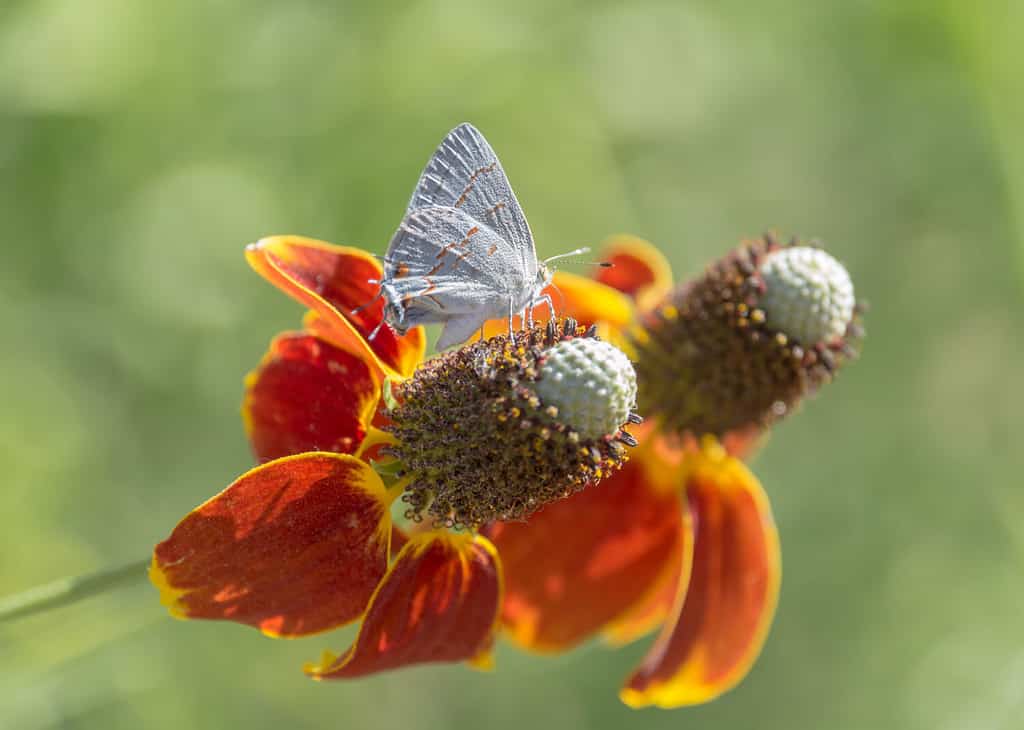
Coneflowers feed pollinators all summer long.
©Lori Bonati/Shutterstock.com
14. Turtlehead
Turtlehead flowers look like, you’ve guessed it, turtle heads. These native perennials bloom pink or white in mid-summer until fall on two-to-three-foot tall stems. Attractive mid-green serrated foliage forms a colorful clump around its stems and gives visiting hummingbirds safe cover.
This is one of the best perennials for Kentucky’s damp yards and moist, woodland-style gardens. They don’t like dry soil or too much sun on their roots, so plant them near a water source in partial shade.
Expect turtlehead blooms in July through to fall each year, but if it’s your first time, plant them out in early spring. This perennial native grows easily from seed but won’t form flowers until the following year.

Chelone plant flower spikes can grow 2-3 feet tall.
©imageBROKER.com/Shutterstock.com
15. Buddleia
Butterfly bush buddleia lives up to its name. Butterflies universally love its easy-to-access clusters of tiny flowers that form a cone. Buddleia is native to the Far East, and in some U.S. states, it’s invasive, but Kentucky does not have a problem with invasive buddleia.
Plant out in full sun during early spring and expect flowers that year. Deadheading buddleia’s brown flowers produce more flowers across the season. In the fall, hard prune buddleia back to six or eight inches. Don’t worry. It will regenerate the following year and grow back to its full height.
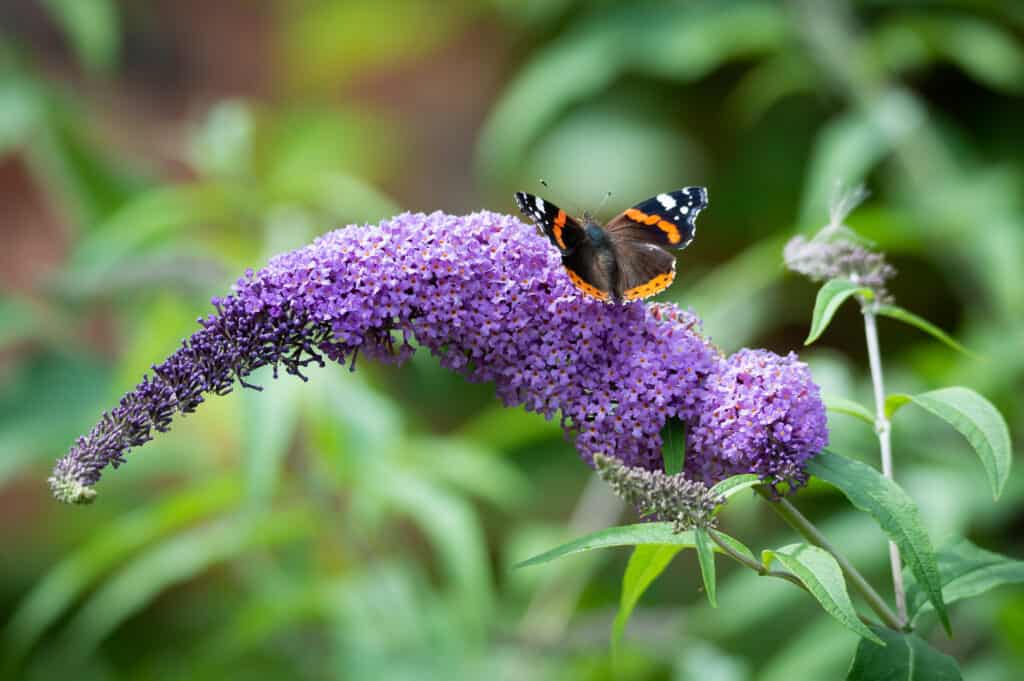
Cut buddleia back to six inches each fall to avoid a tangle of woody branches.
©iStock.com/EstuaryPig
16. Mallow
Mallow, better known as Rose of Sharon or Hibiscus Syriacus, is one of the best perennials for Kentucky because its gorgeous pink, white, or purple trumpet-shaped flowers bloom profusely without much help.
This beauty loves well-drained, fertile soil and full sun to partial shade. It can grow to eight feet tall and several feet wide in the right conditions. Stick to dwarf mallow if space is at a premium.
Mallow tends to bloom later in the season, in July, and produces flowers until fall. In the warmer western side of Kentucky, it may retain its large green foliage for winter, but it dies back in colder zones.

Rose of Sharon blooms late in the season from July to the fall.
©Stock for you/Shutterstock.com
17. Black-Eyed Susan
Southern belle black eye susan is an American garden staple. It’s a familiar sight in Kentucky because it’s gorgeous and easy to grow.
Black-eyed susan delivers vivid, bright yellow color and fills the border with shape. It’s a cheerful, hardworking daisy-like plant that blooms from mid-spring right through to the fall when it gifts a huge number of seeds to birds.
Full sun and well-drained fertile soil are best for this grafter. It’s a no-brainer perennial for Kentucky. Plant your first batch from seed in late spring and expect three-foot-tall flowers within three months. Because flowerheads are so abundant, flower arrangers can select stems without spoiling their garden display.
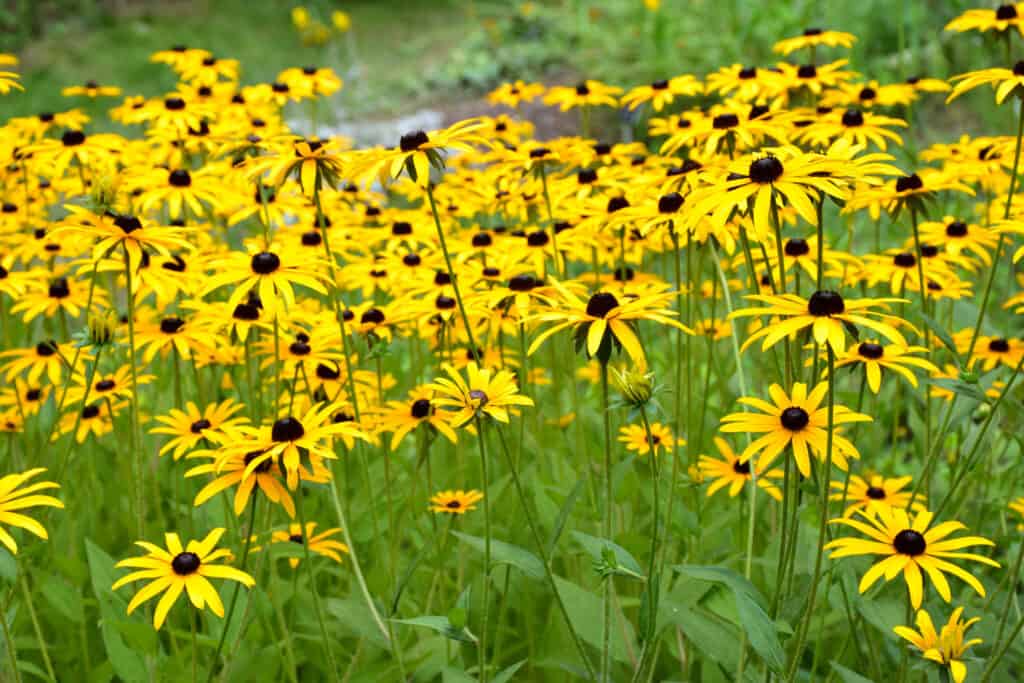
Popular black-eyed susan is a tough perennial that requires little maintenance.
©Irena Socratous/Shutterstock.com
18. Lafter Rose
Lafter rose is an antique shrub rose that loves Kentucky’s climate. It’s a prolific bloomer in full sun, producing fruit-scented four-inch wide pink, yellow, and orange double roses from late spring to late summer.
Plant blackspot-resistant Lafter rose in manure-rich soil and give it plenty of water in dry spells. The best time to plant roses is during the fall because the soil is warm and wet, but you can plant them in early spring and give them lots of water to help establish a strong root system.
Spotted aphids on your Lafter rose? Hunt down a few ladybugs who will happily polish them off for dinner.

Beautiful Lafter rose has a fruity scent and double blooms.
©Evelyn Tu/Shutterstock.com
19. Hardy Geraniums
Hardy geraniums (that’s not tender pelargoniums that folks sometimes call geraniums) thrive in zones 4a and above. One of the most popular is purple flowering Rozanne.
Geranium Rozanne produces fluffy foliage from mid-spring, after daffodils and tulips have died down, and blooms prolifically from late June until fall. Pollinators love this purple-blooming tough cookie,; because its seeds are sterile, they won’t spread. Wait two to three years, then divide the clump if you fancy more of this hardy perennial geranium that grows in all well-drained soils.

Geraniums grow in all conditions except waterlogged spots.
©guentermanaus/Shutterstock.com
The photo featured at the top of this post is © iStock.com/Haidamac
Thank you for reading! Have some feedback for us? Contact the AZ Animals editorial team.






